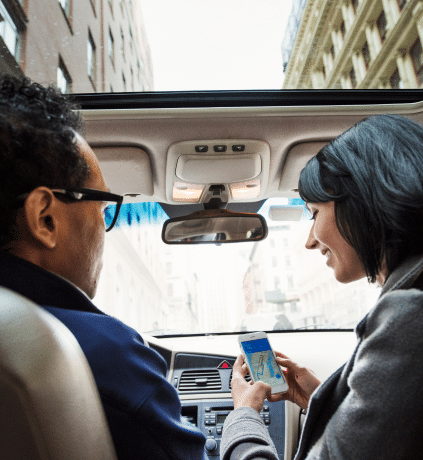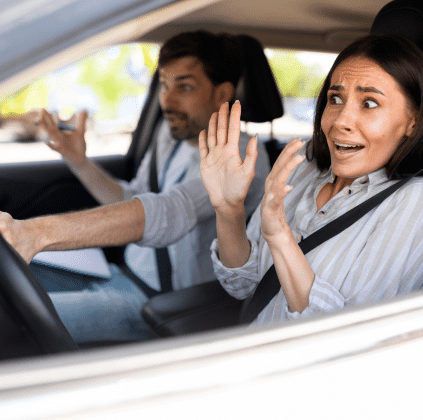Rideshare Safety Tips:
A Complete Guide
Rideshare apps are a convenient way to get around town, especially when traveling at night, leaving a bar after drinking, or just trying to avoid parking hassles. However, using a rideshare app means getting into a stranger’s car, which is never completely risk-free. Often, dangerous situations such as speeding or reckless driving put you at risk of injury in a car crash. In more serious cases, rideshare passengers have been physically attacked, sexually harassed, or assaulted.
When traveling in rideshare vehicles, it’s important to prioritize your own safety at all times. Certain steps can help you ensure your safety and avoid injury and other serious health and safety risks.
Tips for General Rideshare Safety
Anyone using a rideshare app is potentially at risk of being hurt in a motor vehicle accident or deliberately harmed by a driver. Here are some safety tips for anyone who frequently uses rideshare services:
- Request your ride before going outside. Lingering outside alone while looking down at your phone is dangerous.
- Keep your phone charged when you go out. This will not only prevent you from being stuck without a ride but also allow you to text or call someone in an emergency.
- Before boarding, make sure the car, license plate, and driver are correct. Don’t get into a car until you’ve confirmed that the car and driver match those assigned to you.
- Have the driver confirm your name. Don’t walk up and ask if a ride is for you. Wait and see if the driver knows your name before entering the car.
- Check if the child safety lock has been activated before entering the car. One key danger of rideshare vehicles is that a driver can covertly activate the child lock, trapping you in the backseat. Make sure you can operate the inside handle normally before closing the door.
- Share your rideshare route with a friend or family member. Many rideshare apps have features that let you text your route to another person so they can follow it in real-time. If your rideshare driver takes an unexpected detour, your trusted contact can find your location.
- Sit in the back seat of the car. Sitting in the front passenger seat puts you very close to the driver, meaning it’s much easier for them to grab or otherwise physically hurt you.
- Always wear your seatbelt. Wearing a seatbelt can prevent injury from a collision.
- Never give out your personal information. Your driver never needs to know your full name, phone number, home address, or other identifying information.
- Never pay cash. You might occasionally see a driver offering rides for cash without a rideshare app. The company likely hasn’t vetted an unregulated cash-only driver, so don’t get into their car.
- Only communicate with your driver in the rideshare app. Don’t text or call a rideshare driver using your own number.
- Keep an eye on your surroundings. Follow the route on your phone to better understand how to get home if you arrive in the wrong place.
- Travel in groups when you can. Sharing a car with people you trust means there are witnesses if anyone gets hurt.
- Trust your instincts. If something doesn’t feel right, don’t get into the vehicle. It’s always okay to cancel the ride if something seems off.
- Call for help if you’re in trouble. If you’re in danger, call a friend, the police, or another trusted party. If needed, shout out the window.
- Exit the vehicle in a safe area. Don’t exit the car somewhere unfamiliar, unexpected, or otherwise dangerous. Try to exit in a brightly lit, familiar space if possible.
Rideshare Safety Considerations for Women
Women using rideshare apps often face unique safety concerns. The most common problems faced by female rideshare users are sexual assault and harassment.
Statistics regarding sexual assault, sexual harassment, and rape incidents in rideshares are concerning. Lyft released its first safety report in 2021, which revealed more than 4,000 reports of sexual assault in two years. Similarly, Uber’s 2022 safety report showed 3,824 reports of sexual assault. Sexual assault in rideshare vehicles remains a serious concern for women who use rideshare apps, including drivers. Female rideshare drivers also commonly report sexual assault and harassment while on the job.
If you ever feel in danger, exit the car as quickly as possible.

College Students and Rideshare Safety
College students comprise a significant portion of rideshare app users. Some universities have implemented measures to promote rider safety, including internal safety apps for students. An increasing number of schools even offer their own rideshare programs for students traveling within a certain distance of campus. If your university has such a program, it’s often a safer alternative to Uber or Lyft. Your school will have vetted participants in the program, and many drivers will be fellow students.

Staying Safe In a Rideshare Vehicle While Traveling Alone
When traveling alone, take extra care to be aware of your surroundings. Chatting with your driver is okay. However, don’t share details about your travel plans, the amount of time you’ll be in the area, whether it’s your first time in the area, etc.
Also, never let them know you are traveling alone because they will know no one will immediately come to look for you if you are harmed. Providing unnecessary information only increases the likelihood that a driver may harm or harass you.
Uber Safety Features
The Uber app incorporates several in-app rider safety measures. Some of these features include:
- On-trip reporting – Uber passengers can report dangerous driving or feeling unsafe while riding.
- Emergency assistance button –The Uber app includes a one-touch button that allows users to call 911 automatically. It displays ride and location details so users can report them to the dispatcher.
- RideCheck – Uber’s “RideCheck” feature detects when a rideshare vehicle veers off-course or crashes so that it can automatically respond to dangerous driving incidents.
Lyft Safety Features
Lyft’s app platform also includes multiple safety features designed to prevent riders from harm. These include:
- Smart Trip Check-In – The Lyft app monitors rides for activity, such as long stops or route deviations. If a trip seems strange, an agent will contact the rider to see if they’re okay.
- Phone number cloaking – Lyft drivers can never see riders’ real phone numbers through the app.
- ADT emergency support – An ADT professional can contact authorities on a rider’s behalf if necessary.
Third-Party Safety Apps
Several third-party safety apps are also available for anyone who wants to share their location with trusted contacts such as friends or family. These apps include programs such as Life360, Aster, and Noonlight. Your phone may also have a location-sharing program, such as the iPhone’s “Find My Friends” feature.
Potential Safety Risks of Self-Driving Vehicles
The use of self-driving or autonomous vehicles in ridesharing is increasing, especially in big cities. Lyft has already begun offering autonomous rideshare services, and Uber will likely follow suit soon.
At first, a self-driving car may seem like a safer option when faced with the inherent dangers of riding with a stranger. However, self-driving cars carry their own unique risks.
In 2022, self-driving cars were responsible for nearly 400 crashes in 11 months. Federal auto safety authorities also have investigated a rash of accidents in which fully autonomous vehicles drifted into traffic or crashed into parked cars.
Reckless Rideshare Drivers
Statistically, roughly 99 percent of rideshare trips end without a safety report. However, there’s always the risk that you’ll be among the unlucky one percent who experience a crash or other safety issue.
Rideshare companies generally have implemented policies to screen drivers for safety purposes. Uber screens all drivers before their first trip and repeats driver screens annually. These screens include background checks, regular identity confirmation, and criminal offense tracking. Lyft also conducts background checks on drivers. Both platforms vet drivers’ vehicles for safety concerns before drivers hit the road.
If you experience reckless or dangerous driving in a rideshare vehicle, you can report a driver through the app.

How To Report an Uber or Lyft Driver
There are three levels of driver reporting available on both Uber and Lyft, depending on the severity of the issue. They are:
Leave the driver a review.
For more minor complaints, such as a rude driver, you can leave a negative review. This feedback lets the rideshare company know there’s a problem with the driver’s conduct.
Email customer service.
Both Lyft and Uber rely on emailed customer service complaints for more serious incidents that do not compromise rider safety.
Call the platform’s safety hotline.
Uber and Lyft both have 24/7 safety hotlines you can call in case of an emergency or use to report an incident. If you’ve been hurt or endangered in a rideshare vehicle, call the hotline immediately to report it.
When to Contact a Lawyer
If you’ve been injured, harassed, or otherwise harmed in a rideshare vehicle, you have legal options. Cordisco & Saile handles rideshare cases of all types, including accidents in Uber or Lyft vehicles and sexual assault by rideshare drivers. We can answer your questions about your rights after a rideshare incident and do everything in our power to pursue the justice and compensation you deserve.
Call (215) 642-2335 or contact us through our website today for a free consultation.

